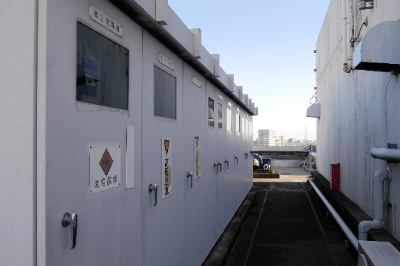What Is a Cubicle?
 A cubicle is a facility that contains a set of high-voltage power receiving equipment and low-voltage substation equipment.
A cubicle is a facility that contains a set of high-voltage power receiving equipment and low-voltage substation equipment.
The voltage of electricity transmitted from a power plant is generally 6,600V, and in most cases, outlets and lighting are powered by 100V or 200V. A cubicle is a metal box containing equipment that steps down the received electricity to the voltage required for the demand facilities.
Generally, a cubicle is installed in facilities that have an electricity supply contract with an electric power company for 50 KW or more.
Uses of Cubicles
Cubicles are installed in all kinds of places, including urban areas and residential areas, such as:
- Commercial facilities such as shopping malls and supermarkets
- Public facilities such as community centers and schools
- Residential facilities such as student dormitories and apartments
- High-rise office buildings
- Processing plants and small factories
Principle of Cubicles
Cubicles consist of power receiving equipment, substation equipment, low-voltage equipment, and an enclosure.
1. Power Receiving Equipment
Power receiving equipment is the equipment used to accept high-voltage power distribution. It mainly consists of disconnectors and circuit breakers.
When a short circuit or ground fault occurs due to the failure of substation equipment or high-voltage distribution lines in cubicles, a large current flows to the upper circuits of the power company’s power grid. If this large current is left unattended, the electric power company’s power grid will be cut off for safety, causing a power outage in the surrounding area. This is a spillover accident.
The role of the circuit breaker is to cut off the power supply when it detects an overcurrent or ground fault in the cubicles to prevent a spillover accident. There are two types of circuit breakers in cubicles: PF-S type and CB type.
The PF-S type uses a high-voltage current-limiting fuse (power fuse) and a load break switch, while the CB type uses a circuit breaker and a protective relay, and most of the circuit breakers are vacuum circuit breakers. The PF/S method is inexpensive and used when the power receiving capacity is small, while the CB method is used when the power receiving capacity is large or when the load current is frequently switched.
2. Substation Equipment
Transformers are devices that convert the high voltage received into low voltage.
Oil-filled transformers and molded transformers are used as transformers. The upper limit for storage in cubicles is approximately 750 kVA, and a separate installation is required for capacities higher than 750 kVA.
In addition, the use of substation equipment causes the current to slow phase. When the current is slow-phased, losses occur in power transmission and distribution. For this reason, many power company supply contracts include clauses that increase the power factor when the power factor drops and the power factor delayed by the capacitor is brought closer to 1.
3. Low-Voltage Equipment
Low-voltage equipment is the equipment used to distribute transformed power to various locations. Wiring circuit breakers and ground-fault circuit breakers fall into this category. Depending on the equipment configuration, electromagnetic contactors and electromagnetic switches may be installed inside the cubicles.
4. Enclosure
The enclosure is an outer metal box to protect the internal equipment. Steel plates of 1 to 3 mm in thickness are mainly used. The outer surface is painted milky white or beige to prevent corrosion and to be pleasing to the eye.
Inside the cubicles, there are parts of the cubicles where the charging section is exposed, which can cause an electric shock if touched without protective measures. There is a risk of electric shock if the inside of cubicles in public facilities is easily penetrated. Door opening/closing handles are often equipped with locks.
Substation equipment and distribution lines have the property of generating heat when electricity is used. If the amount of heat generated is large, there is a risk of heat buildup inside the cubicles, resulting in high temperatures.